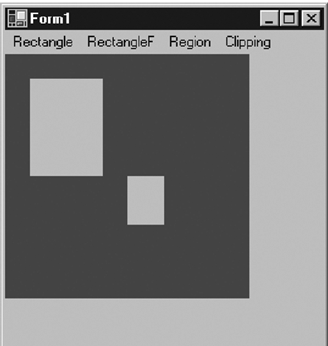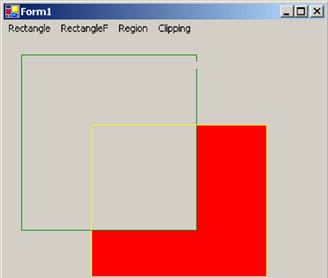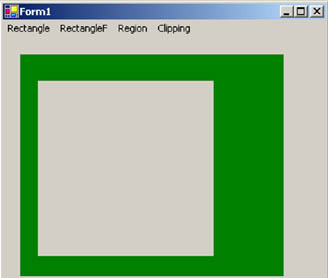Regions and Clipping
As we discussed in Chapter 3, the Graphics class provides methods to clip regions. Using these methods, an application can restrict where graphics objects are drawn. One major use of clipping regions is to repaint only part of a control. In some cases painting an entire form is costly in terms of time and memory resources. Clipping plays a vital role by painting only the desired area. The Graphics class provides the SetClip, ResetClip, IntersectClip, ExcludeClip, and TranslateClip methods to use in clipping operations.
ExcludeClip excludes the area specified by an argument of type Rectangle or a Region and updates the clipping region. Listing 6.11 fills a rectangle, excluding one small rectangle and a region.
Listing 6.11 Using ExcludeClip to clip regions
// Create a Graphics object Graphics g = this.CreateGraphics(); g.Clear(this.BackColor); // Create rectangles Rectangle rect1 = new Rectangle(20, 20, 60, 80); Rectangle rect2 = new Rectangle(100, 100, 30, 40); // Create a region Region rgn1 = new Region(rect2); // Exclude clip g.ExcludeClip(rect1); g.ExcludeClip(rgn1); // Fill rectangle g.FillRectangle(Brushes.Red, 0, 0, 200, 200); // Dispose of object g.Dispose();
Figure 6.11 shows output from Listing 6.11. The small rectangle and small region are not updated.
Figure 6.11. ExcludeClip output

SetClip sets the clipping region of a Graphics object. This method has many overloaded forms and takes parameters of type Rectangle, RectangleF, Region, GraphicsPath, and Graphics with or without the CombineMode enumeration. The CombineMode enumeration defines how different clipping regions can be combined (see Table 6.2).
The ResetClip method resets the clipping region to infinity. Listing 6.12 uses the SetClip, ResetClip, and IntersectClip methods.
Listing 6.12 Using the SetClip, ResetClip, and IntersectClip methods
// Create a Graphics object Graphics g = this.CreateGraphics(); g.Clear(this.BackColor); // Create rectangles and regions Rectangle rect1 = new Rectangle(20, 20, 200, 200); Rectangle rect2 = new Rectangle(100, 100, 200, 200); Region rgn1 = new Region(rect1); Region rgn2 = new Region(rect2); // Call SetClip g.SetClip(rgn1, CombineMode.Exclude); // Call IntersectClip g.IntersectClip(rgn2); // Fill rectangle g.FillRectangle(Brushes.Red, 0, 0, 300, 300); // Call ResetClip g.ResetClip(); // Draw rectangles g.DrawRectangle(Pens.Green, rect1); g.DrawRectangle(Pens.Yellow, rect2); // Dispose of object g.Dispose();
|
Member |
Description |
|---|---|
|
Complement |
The existing region is replaced by the result of the existing region being removed from the new region. |
|
Exclude |
The existing region is replaced by the result of the new region being removed from the existing region. |
|
Intersect |
Two clipping regions are combined, and the result is their intersection. |
|
Replace |
One clipping region replaces the other. |
|
Union |
Two clipping regions are combined, and the result is their union. |
|
Xor |
Two clipping regions are combined, and the result is their union minus their intersection. |
Note
The CombineMode enumeration is defined in the System.Drawing.Drawing2D namespace.
Figure 6.12 shows the output from Listing 6.12.
Figure 6.12. Using Clip methods

TranslateClip translates the clipping region as specified. Listing 6.13 uses the TranslateClip method to translate a region by 20 and 30 points.
Listing 6.13 Using TranslateClip to translate a region
// Create a Graphics object Graphics g = this.CreateGraphics(); g.Clear(this.BackColor); // Create a RectangleF rectangle RectangleF rect1 = new RectangleF(20.0f, 20.0f, 200.0f, 200.0f); // Create a region Region rgn1 = new Region(rect1); // Call SetClip g.SetClip(rgn1, CombineMode.Exclude); float h = 20.0f; float w = 30.0f; // Call TranslateClip with h and w g.TranslateClip(h, w); // Fill rectangle g.FillRectangle(Brushes.Green, 20, 20, 300, 300);
Figure 6.13 shows the output from Listing 6.13.
Figure 6.13. Using TranslateClip

GDI+: The Next-Generation Graphics Interface
- GDI+: The Next-Generation Graphics Interface
- Understanding GDI+
- Exploring GDI+ Functionality
- GDI+ from a GDI Perspective
- GDI+ Namespaces and Classes in .NET
- Summary
Your First GDI+ Application
- Your First GDI+ Application
- Drawing Surfaces
- The Coordinate System
- Tutorial: Your First GDI+ Application
- Some Basic GDI+ Objects
The Graphics Class
- The Graphics Class
- Graphics Class Properties
- Graphics Class Methods
- The GDI+Painter Application
- Drawing a Pie Chart
Working with Brushes and Pens
- Working with Brushes and Pens
- Understanding and Using Brushes
- Using Pens in GDI+
- Transformation with Pens
- Transformation with Brushes
- System Pens and System Brushes
- A Real-World Example: Adding Colors, Pens, and Brushes to the GDI+Painter Application
Colors, Fonts, and Text
- Colors, Fonts, and Text
- Accessing the Graphics Object
- Working with Colors
- Working with Fonts
- Working with Text and Strings
- Rendering Text with Quality and Performance
- Advanced Typography
- A Simple Text Editor
- Transforming Text
Rectangles and Regions
- Rectangles and Regions
- The Rectangle Structure
- The Region Class
- Regions and Clipping
- Clipping Regions Example
- Regions, Nonrectangular Forms, and Controls
Working with Images
- Working with Images
- Raster and Vector Images
- Working with Images
- Manipulating Images
- Playing Animations in GDI+
- Working with Bitmaps
- Working with Icons
- Skewing Images
- Drawing Transparent Graphics Objects
- Viewing Multiple Images
- Using a Picture Box to View Images
- Saving Images with Different Sizes
Advanced Imaging
- Advanced Imaging
- Rendering Partial Bitmaps
- Working with Metafiles
- Color Mapping Using Color Objects
- Image Attributes and the ImageAttributes Class
- Encoder Parameters and Image Formats
Advanced 2D Graphics
- Advanced 2D Graphics
- Line Caps and Line Styles
- Understanding and Using Graphics Paths
- Graphics Containers
- Reading Metadata of Images
- Blending Explained
- Alpha Blending
- Miscellaneous Advanced 2D Topics
Transformation
- Transformation
- Coordinate Systems
- Transformation Types
- The Matrix Class and Transformation
- The Graphics Class and Transformation
- Global, Local, and Composite Transformations
- Image Transformation
- Color Transformation and the Color Matrix
- Matrix Operations in Image Processing
- Text Transformation
- The Significance of Transformation Order
Printing
- Printing
- A Brief History of Printing with Microsoft Windows
- Overview of the Printing Process
- Your First Printing Application
- Printer Settings
- The PrintDocument and Print Events
- Printing Text
- Printing Graphics
- Print Dialogs
- Customizing Page Settings
- Printing Multiple Pages
- Marginal Printing: A Caution
- Getting into the Details: Custom Controlling and the Print Controller
Developing GDI+ Web Applications
- Developing GDI+ Web Applications
- Creating Your First ASP.NET Web Application
- Your First Graphics Web Application
- Drawing Simple Graphics
- Drawing Images on the Web
- Drawing a Line Chart
- Drawing a Pie Chart
GDI+ Best Practices and Performance Techniques
- GDI+ Best Practices and Performance Techniques
- Understanding the Rendering Process
- Double Buffering and Flicker-Free Drawing
- Understanding the SetStyle Method
- The Quality and Performance of Drawing
GDI Interoperability
Miscellaneous GDI+ Examples
- Miscellaneous GDI+ Examples
- Designing Interactive GUI Applications
- Drawing Shaped Forms and Windows Controls
- Adding Copyright Information to a Drawn Image
- Reading and Writing Images to and from a Stream or Database
- Creating Owner-Drawn List Controls
Appendix A. Exception Handling in .NET
- Frame-Mode MPLS Configuration and Verification
- Basic MPLS VPN Overview and Configuration
- Implementing BGP in MPLS VPNs
- Configuration and Implementation of MPLS QoS in Uniform Mode and Short Pipe Mode Operation
- Case Study 2: Implementing Multi-VRF CE, VRF Selection Using Source IP Address, VRF Selection Using Policy-Based Routing, NAT and HSRP Support in MPLS VPN, and Multicast VPN Support over Multi-VRF CE
